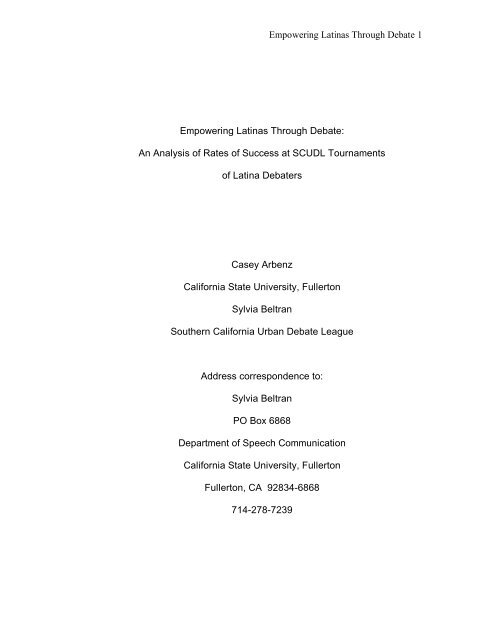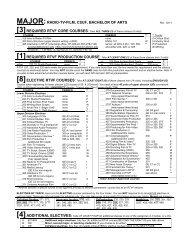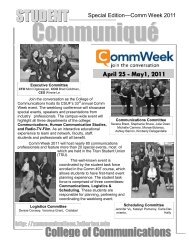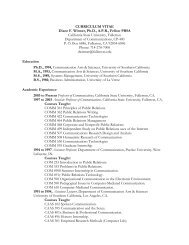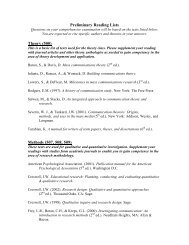Empowering Latinas Through Debate - College of Communications ...
Empowering Latinas Through Debate - College of Communications ...
Empowering Latinas Through Debate - College of Communications ...
You also want an ePaper? Increase the reach of your titles
YUMPU automatically turns print PDFs into web optimized ePapers that Google loves.
<strong>Empowering</strong> <strong>Latinas</strong> <strong>Through</strong> <strong>Debate</strong>:<br />
<strong>Empowering</strong> <strong>Latinas</strong> <strong>Through</strong> <strong>Debate</strong> 1<br />
An Analysis <strong>of</strong> Rates <strong>of</strong> Success at SCUDL Tournaments<br />
<strong>of</strong> Latina <strong>Debate</strong>rs<br />
Casey Arbenz<br />
California State University, Fullerton<br />
Sylvia Beltran<br />
Southern California Urban <strong>Debate</strong> League<br />
Address correspondence to:<br />
Sylvia Beltran<br />
PO Box 6868<br />
Department <strong>of</strong> Speech Communication<br />
California State University, Fullerton<br />
Fullerton, CA 92834-6868<br />
714-278-7239
<strong>Empowering</strong> <strong>Latinas</strong> <strong>Through</strong> <strong>Debate</strong>:<br />
<strong>Empowering</strong> <strong>Latinas</strong> <strong>Through</strong> <strong>Debate</strong> 2<br />
An Analysis <strong>of</strong> Rates <strong>of</strong> Success at SCUDL Tournaments<br />
<strong>Debate</strong> empowers debaters. Speaking from personal experience, we can<br />
honestly say that policy debate is one <strong>of</strong> the most empowering and<br />
transformative activities a high school student can participate in. Speaking as a<br />
Latina who began debating in high school, debate has affected me in ways that<br />
have quite literally changed the course <strong>of</strong> my life. I was one <strong>of</strong> two <strong>Latinas</strong> in my<br />
high school honors courses and the only Latina on my high school debate team.<br />
During my three years debating in high school I never met another female <strong>of</strong><br />
Latin descent from another school that either self-identified or was identifiable as<br />
Latina. During my four years debating in college, my encounters with other<br />
women <strong>of</strong> Latin descent were so limited that I although I know I must have met<br />
one or two <strong>Latinas</strong> along the way, I cannot recall them by name. The first time I<br />
had a meaningful interaction with a Latina who was also a debater was when I<br />
judged my first New York Urban <strong>Debate</strong> League tournament. It was only then<br />
that I realized the pr<strong>of</strong>ound privilege <strong>of</strong> being around people who “look like you”<br />
that many other debaters take for granted.<br />
Who are <strong>Latinas</strong>? By the term “Latina” we will be referring to the diverse<br />
group researchers and US government census takers alike refer to including<br />
women who descended from countries in Central and South America, Mexico,<br />
Puerto Rico, Cuba and the Dominican Republic (Garza, 1994). By seeking to<br />
study this group, our aim is not to essentialize or characterize in broad strokes.
<strong>Empowering</strong> <strong>Latinas</strong> <strong>Through</strong> <strong>Debate</strong> 3<br />
Indeed, both authors recognize and embrace the diversity <strong>of</strong> women<br />
encompassed by the term Latina. Indeed, we utilize the term Latina with full<br />
knowledge that some women who fall into this category might not embrace this<br />
term as fully as scholars in this field have embraced it, and use it only for clarity’s<br />
sake.<br />
<strong>Latinas</strong> in high school as a group are more likely to dropout, are more<br />
likely to get pregnant, attempt suicide at higher rates, and are more likely to have<br />
used marijuana and cocaine than white or African American girls the same age<br />
(Navarro, 2001). <strong>Latinas</strong> are attending the same high schools as their white and<br />
African American counterparts, but they are not doing as well as women <strong>of</strong> other<br />
ethnicities. It is no coincidence that I had trouble encountering girls <strong>of</strong> my same<br />
background when I was participating in high school forensics. Despite the<br />
alarming fact that <strong>Latinas</strong> face many social and institutional barriers to staying in<br />
school, remarkably little is being done to combat this crisis (Vives, 2001).<br />
Indeed, <strong>Latinas</strong>, like many other women <strong>of</strong> color, are <strong>of</strong>ten rendered invisible by<br />
virtue <strong>of</strong> the fact that policymakers and other individuals in positions <strong>of</strong> power<br />
<strong>of</strong>ten focus their attention on white women and minority men (Flores, 1990;<br />
Lopez, 1995; Galindo and Gonzalez, 1999; Garcia, 1997).<br />
This study seeks to determine whether rates <strong>of</strong> participation and success<br />
in the Southern California Urban <strong>Debate</strong> League present hope for debate to be<br />
utilized as a means <strong>of</strong> empowering <strong>Latinas</strong> and bridging the educational gap.<br />
We will focus on the SCUDL for two reasons. First, the SCUDL is located in<br />
Southern California, home to many Latin American communities. Second, the
<strong>Empowering</strong> <strong>Latinas</strong> <strong>Through</strong> <strong>Debate</strong> 4<br />
SCUDL is the UDL both authors are most familiar with since we have both been<br />
involved with this organization since its inception, both in volunteer and<br />
administrative capacities, respectively.<br />
The Southern California Urban <strong>Debate</strong> League (SCUDL) is an<br />
organization that seeks to bring debate to those students who attend<br />
economically underserved high schools. It is one <strong>of</strong> 13 Urban <strong>Debate</strong> Leagues<br />
(UDLs) located in cities across the United States, including New York, Chicago,<br />
Atlanta and Baltimore. Students <strong>of</strong> many different ethnicities and backgrounds,<br />
including <strong>Latinas</strong> compete in the SCUDL and in UDLs across the country. Until<br />
the advent <strong>of</strong> the UDL, debate was largely the domain <strong>of</strong> the rich, suburban high<br />
school or more frequently, the private school. The Open Society Institute (OSI)<br />
began making grants to bring debate back to underserved high schools in 1997.<br />
The goal <strong>of</strong> the program is to make debate accessible to those schools most in<br />
need <strong>of</strong> the skills debate provides (Breger, 1998).<br />
The skills and benefits debate <strong>of</strong>fers are wide-ranging. By virtue <strong>of</strong> its<br />
quick pace and the constant need to back up one’s arguments with evidence,<br />
debate enables students to develop many critical skills including research,<br />
argument development, and organization. Carrie Crenshaw (1998) argues:<br />
The benefits to the high school students and teachers are irrefutable.<br />
There is ample evidence documenting the benefits <strong>of</strong> debate participation<br />
in part because it provides pre-pr<strong>of</strong>essional preparation, improvement <strong>of</strong><br />
students’ educational experience and communication skills, and it supplies<br />
training for coping the information age. Participation in debate teaches<br />
students many skills including argument construction and evaluation,<br />
library research, as well as information processing, integration, and<br />
management. It also exposes students to the important social issues <strong>of</strong><br />
our time and promotes depth <strong>of</strong> study, complex analysis and focused<br />
critical thinking. (p. 83)
<strong>Empowering</strong> <strong>Latinas</strong> <strong>Through</strong> <strong>Debate</strong> 5<br />
Proving a causal relationship between debate and increasing students academic<br />
performance would be difficult, but debate has been credited as improving critical<br />
thinking and analytical skills by recently conducted meta analysis (Allen,<br />
Berkowitz, Hunt, & Louden, 1999). Therefore, debate can be considered a<br />
component in the strategy <strong>of</strong> improving students grades and academic<br />
performance.<br />
In addition to direct educational benefits, debate empowers those who are<br />
lucky enough to participate in its pedagogy. Bruschke and Warner (2001)<br />
discuss the benefits debate <strong>of</strong>fers to its participants:<br />
<strong>Debate</strong> teaches students to become critical thinkers because <strong>of</strong> its<br />
dialectical nature. Students in the habit <strong>of</strong> questioning the claims <strong>of</strong><br />
others and thinking through the possible objections to their own<br />
claims easily develop the mental faculties needed to become active<br />
consumers <strong>of</strong> information. Rather than simply taking knowledge<br />
<strong>of</strong>fered to them at face value, students almost automatically begin<br />
thinking through possible objections to any knowledge claim and<br />
develop probing questions about it. (p. 8)<br />
Indeed, one former Urban <strong>Debate</strong> League participant turned UDL organizer, Ed<br />
Lee (1998), had the following to say about his experience:<br />
<strong>Debate</strong> allows students to take control <strong>of</strong> their educational destiny<br />
and at once make it a site <strong>of</strong> resistance. It allows those saddled<br />
with the baggage <strong>of</strong> poverty, racism and sexism to construct their<br />
personal strategy for liberation. The Urban <strong>Debate</strong> League<br />
provides a space for us to learn what justice is because it forces us<br />
to learn from those disproportionately affected by injustice. (p. 96)<br />
<strong>Debate</strong> has a pr<strong>of</strong>ound influence on its participants via the skills it enables<br />
participants to develop. It affords the critical thinking skills students in
<strong>Empowering</strong> <strong>Latinas</strong> <strong>Through</strong> <strong>Debate</strong> 6<br />
underserved high school need to question critical assumptions they or others<br />
might make about their abilities.<br />
<strong>Debate</strong> can be a very powerful connection to the college world. Several<br />
participants in the SCUDL have no connection to any college experience. Many<br />
students’ siblings and/or parents have not attended college. For those who have<br />
never been exposed to college, the possibility <strong>of</strong> attending college can seem<br />
remote and daunting. Financial aid forms, college applications,<br />
recommendations, etc., work together to form a process which can be both<br />
foreign and overwhelming to any college senior, let alone the student whose<br />
parents are entirely unfamiliar with the process and perhaps do not even speak<br />
the same language required by the English-only applications. <strong>Debate</strong>, by virtue<br />
<strong>of</strong> bringing students to college campuses and college debaters to coach high<br />
school students, can serve a critical function in enfranchising more individuals<br />
into looking at college as a viable option (Arbenz and Beltran, 2000).<br />
This has been only a brief summary and discussion <strong>of</strong> the benefits debate<br />
<strong>of</strong>fers its participants and specifically those benefits <strong>of</strong>fered to the typical UDL<br />
student. Indeed, the purpose <strong>of</strong> this article is not merely to argue the benefits <strong>of</strong><br />
debate but to further investigate if these benefits are reaching one particular<br />
group involved in the UDLs: <strong>Latinas</strong>. Girls in their teens have lacked a forum for<br />
expressing their views. Some recent work has been dedicated to providing girls<br />
with a medium for expressing their views about growing up, education,<br />
friendships, and hardships in their own words (see Findlen, 1995 and Shandler,<br />
1999). These works largely focused on and featured non-Latin girls discussing
<strong>Empowering</strong> <strong>Latinas</strong> <strong>Through</strong> <strong>Debate</strong> 7<br />
the issues salient to their lives. The following is an excerpt from the only Latina<br />
who did participate in the either <strong>of</strong> the two projects, a fifteen year old named<br />
Karisma Amelia Rodriquez provides a dramatic insight into how some <strong>Latinas</strong><br />
view their “place” in the world:<br />
In Latino culture, if you were a woman, you were worthless. You could be<br />
sold as a maidservant/slave to a man for the rest <strong>of</strong> your life. You had to<br />
do everything exactly as you were told. You were at the mercy <strong>of</strong> your<br />
master. Your dignity was hidden, if not destroyed. Here, in the United<br />
States, you are still worthless for being a woman, and despised for being<br />
Latino. Your fault doubles. (Shandler, pp. 248-249).<br />
Indeed, <strong>Latinas</strong> who view themselves the victims <strong>of</strong> sexism in addition to racism<br />
may feel doubly disadvantaged (Garza, 1994).<br />
A revolutionary study has recently been released by the American<br />
Association <strong>of</strong> University Women (AAUW) Education Foundation , with regard to<br />
<strong>Latinas</strong> and secondary education. The report “Si, Se Puede! Yes, We Can:<br />
<strong>Latinas</strong> in School,” (2000) examines the experiences <strong>of</strong> <strong>Latinas</strong> in the US<br />
educational system. This study is important in that it undertakes the task <strong>of</strong><br />
examining how and why <strong>Latinas</strong> are not “succeeding” in as great <strong>of</strong> numbers as<br />
non-Latina girls. Initially, the study examines social characteristics which might<br />
influence the likelihood <strong>of</strong> success for young <strong>Latinas</strong> in school. Ginorio and<br />
Huston (2000) discuss the differences between what a young Caucasion girl<br />
experiences growing up in comparison to what a young Latina experiences:<br />
<strong>Latinas</strong> may find that family, community, school, and peer expectations<br />
are more discordant for them than for girls <strong>of</strong> Anglo, middle-class culture.<br />
Family expectations that children, especially daughters, stay relatively<br />
close to home during and after high school conflict somewhat with a<br />
prevailing trend in middle-class culture for successful students to go away<br />
to college for four years. Similarly, the expectation that women postpone<br />
motherhood or marriage while completing an education may conflict with
<strong>Empowering</strong> <strong>Latinas</strong> <strong>Through</strong> <strong>Debate</strong> 8<br />
family or cultural norms <strong>of</strong> earlier marriage or more extensive family<br />
loyalties and commitments than is typical in Anglo, middle class culture.<br />
(p. 10)<br />
Social influences have a pr<strong>of</strong>ound effect on how <strong>Latinas</strong> approach their<br />
educational endeavors. It is important to note that many Latin parents do support<br />
their daughters’ desire to attend college. A recent study showed that Hispanic<br />
parents value education as essential to attaining middle class status and being<br />
part <strong>of</strong> the “American Dream,” more so than white parents. For example,<br />
Hispanic parents were twice as likely as white parents to rate a college education<br />
as the single most important factor in a young person’s success (Immeerwahr,<br />
2000). Alarmingly, however, according to the same study, Hispanic students’<br />
participation in higher education was the lowest compared to Black and white<br />
students, with only 20% <strong>of</strong> 18-24 year olds participating.<br />
Educational institutions also play a role in socializing <strong>Latinas</strong> into thinking<br />
that they deserve a lower status than other non-Latina students. According to<br />
Ginorio and Huston (2000), a critical component contributing to this socialization<br />
may be teachers in high schools:<br />
Teachers may have trouble moving beyond their own sterotypes <strong>of</strong><br />
<strong>Latinas</strong>’ educational possibilities (or probabilities, in their minds) and thus<br />
promote an education-dismissive environment. Many Latina/o students<br />
report that their teachers did not encourage them to consider college<br />
(Rodriquez: 1993). Evidence suggests that Anglo teachers have lower<br />
expectations for the academic performance <strong>of</strong> Hispanic students than do<br />
Hispanic teachers and that these expectations may be a crucial – and<br />
rectifiable – element <strong>of</strong> teacher education. However, teachers’<br />
expectations about academic performance are related to a student’s<br />
chances <strong>of</strong> attending college. When evaluating students who are<br />
expected to attend college, Anglo and Hispanic teachers had similar<br />
academic expectations for their students. In this way, teachers may be<br />
education-encouraging for individual students while simultaneously<br />
endorsing an education-dismissive environment. However, Hispanic
<strong>Empowering</strong> <strong>Latinas</strong> <strong>Through</strong> <strong>Debate</strong> 9<br />
teachers’ evaluations remained high for non-college bound students, while<br />
Anglo teachers’ expectations were lower. (pp. 10-11).<br />
With regard to graduation rates, the rate for <strong>Latinas</strong> is lower than for girls in any<br />
other racial or ethnic group. Indeed once <strong>Latinas</strong> leave school, they are far less<br />
likely than non-Latina females and all other males to return to school (Ginorio,<br />
2000). There are many social factors that might play a role in this statistic, but<br />
the role the schools play should not be overlooked.<br />
Indeed there could be some conflicting values between parents and high<br />
schools which may alienate <strong>Latinas</strong> even further (Griego, 2001). Schools value<br />
competition and independence, where many argue that traditional Hispanic<br />
family values include cooperation, and dependence. Schools value education<br />
above all else. Hispanic families <strong>of</strong>ten put the family as the highest value,<br />
encouraging young <strong>Latinas</strong> to help support the family by working or taking care <strong>of</strong><br />
younger siblings and other household chores (Navarro, 2001; Ginorio and<br />
Huston, 2001). Some scholars have taken to calling the code <strong>of</strong> behavior<br />
expected <strong>of</strong> Latin women from an early age, marianismo, a difficult balance<br />
between family and culture and the “outside” world (Navarro, 2001).<br />
Given the fact that <strong>Latinas</strong> are facing unique challenges socially, culturally<br />
and institutionally, we undertook to determine whether <strong>Latinas</strong> as a group were<br />
succeeding in a setting that seeks to benefit all underserved students in general,<br />
but in no way targets the specific group <strong>of</strong> <strong>Latinas</strong>, specifically.<br />
Method<br />
In a 4x4 factorial design, the cumulative results from 7 different Southern<br />
California Urban <strong>Debate</strong> League high school tournaments were evaluated. Both
<strong>Empowering</strong> <strong>Latinas</strong> <strong>Through</strong> <strong>Debate</strong> 10<br />
speaker and partner ethnicity were coded and included the following categories:<br />
Latina, non-Latina female, Latino, and non-Latino male. The dependent<br />
variables were the number <strong>of</strong> wins speaker points per round. Speaker points<br />
were divided by the number <strong>of</strong> rounds for the tournament to create an average<br />
number <strong>of</strong> speaker points per round, and wins were divided by the number <strong>of</strong><br />
rounds to create the win percentage. The unit <strong>of</strong> analysis was an individual<br />
debater’s performance at a given tournament.<br />
Win percentage<br />
Results<br />
Although the results <strong>of</strong> the ANOVA test showed no statistical significance<br />
at the .05 level between ethnicity and wins per round, a p level <strong>of</strong> .053 was<br />
obtained (F(3, 234) = 2.6) and was deemed <strong>of</strong> sufficient importance to warrant<br />
further analysis. The lowest winning percentage was for <strong>Latinas</strong> (.45), followed<br />
by Latinos (.51), non-Latino males (.55) and non-Latina females (.58). There<br />
was a significant interaction between speaker ethnicity and partner ethnicity (F(9,<br />
234) = 2.30, p = .017). The average wins for two <strong>Latinas</strong> is only .39. The<br />
average wins for a Latina with a female non-Hispanic partner is .39; Latina and<br />
Latino is .52, and Latina with male non-Latino is .56. This shows that a Latina<br />
partnered with another Latina debater will only win about 39% <strong>of</strong> their debate<br />
rounds. The highest win percentage, however, was .85 and was obtained for<br />
teams consisting <strong>of</strong> a non-Latina female and a non-Latino male. These results<br />
indicate that gender may not affect the tournament results for a team, except
<strong>Empowering</strong> <strong>Latinas</strong> <strong>Through</strong> <strong>Debate</strong> 11<br />
when the ethnicity <strong>of</strong> that female is Hispanic. Because <strong>of</strong> the extremely small cell<br />
sizes for the interaction (cell sizes ranged between 6 and 34), we suggest<br />
interpreting these results with caution. Still, it is clear that <strong>Latinas</strong> had the lowest<br />
success rates, enjoyed success only when debating males and especially non-<br />
Latino males, and even in those instances did not enjoy as much success<br />
debating with non-Latino males as did non-Latina females.<br />
Speaker Points<br />
There was no relationship between gender and ethnicity <strong>of</strong> a debate team<br />
and speaker points (F(3, 234) = 1.73, p = .76). The interaction between speaker<br />
ethnicity and partner ethnicity was similarly non-significant. This indicates that<br />
the ethnicity <strong>of</strong> the female speaker does not directly influence the judge’s<br />
decision to award speaker points.<br />
Discussion<br />
Results <strong>of</strong> this study reveal that the amount <strong>of</strong> wins a debater earned was<br />
directly correlated to his or her gender/ethnicity. <strong>Latinas</strong> had the lowest overall<br />
winning percentage, followed by non-Latina females, followed by Latinos and<br />
then finally, non-Latino males. These findings are particularly important given the<br />
fact that they measure success in the Urban <strong>Debate</strong> League, an organization that<br />
seeks to provide opportunities for underserved students. Even within the UDL,<br />
systemic discrimination continues. A positive finding <strong>of</strong> the study, and indeed a<br />
reason to believe that debate has untapped potential for enfranchising <strong>Latinas</strong>, is<br />
that no correlation was found between gender/ethnicity and speaker points.<br />
<strong>Latinas</strong> had roughly the same speaker points as all other non-Latina debaters.
<strong>Empowering</strong> <strong>Latinas</strong> <strong>Through</strong> <strong>Debate</strong> 12<br />
This fact provides us with hope that although the SCUDL may still experience<br />
systemic discrimination, this discrimination is not so widespread and endemic<br />
that it could not be addressed and, potentially, alleviated.<br />
Recommendations<br />
What can and must be done to ensure that UDLs address the specific<br />
needs <strong>of</strong> <strong>Latinas</strong> which are currently not being served? First, all hope is not lost.<br />
By virtue <strong>of</strong> providing space for all underserved students, including <strong>Latinas</strong>, to<br />
participate in policy debate, the UDL is opening the door for more widespread<br />
participation. The AAUW study indicates that participation in extra-curricular<br />
activities such as student government or sports, have been shown to facilitate<br />
academic success in <strong>Latinas</strong> (Ginorio and Huston, 2000). Additionally, academic<br />
programs which improve academic skills, have been found to counter institutional<br />
barriers found at the school level. (Romo, 1998). Additionally, Romo (1998)<br />
found that “school programs that promote self-efficacy, self-confidence and high<br />
expectations are as important as programs that provide opportunities for<br />
academic and career success (p. 4). We have already demonstrated that<br />
debate <strong>of</strong>fers these skills, as well as many others to debaters. <strong>Debate</strong> via the<br />
UDLs has the potential to empower <strong>Latinas</strong> to succeed in high school and<br />
beyond. Reforms must be meaningful and take into account the needs <strong>of</strong> distinct<br />
populations if UDLs are truly going to serve those who would benefit from debate<br />
the most.<br />
Recognizing the problem is the most important step. <strong>Through</strong>out this<br />
paper, we have argued that even among those who are considered underserved
<strong>Empowering</strong> <strong>Latinas</strong> <strong>Through</strong> <strong>Debate</strong> 13<br />
students, <strong>Latinas</strong> are their own special class who warrant their own attention,<br />
study and consideration. We must recognize that we are failing <strong>Latinas</strong> before<br />
we can begin to address the issues surrounding the failure. Those students<br />
which the UDL seeks to assist, those students most in need <strong>of</strong> the skills that<br />
debate affords its participants are not just underserved students in general, they<br />
are <strong>Latinas</strong>, specifically. UDLs everywhere need to recognize that <strong>of</strong> all the<br />
students the public school system is failing, they are failing <strong>Latinas</strong> the worst.<br />
Recognition is only the first step to combating this problem. Several other<br />
steps need to be taken in order for the mission <strong>of</strong> the UDLs to be furthered with<br />
regard to Latina debaters. Romo (1998) cites various factors as key to <strong>Latinas</strong>’<br />
success including: valuing students language and culture, involving parents,<br />
providing staff training, and creating a sense <strong>of</strong> community. The most important<br />
factor for <strong>Latinas</strong>’ success is the belief that they can succeed. In the debate<br />
context, teacher and judge training that would include cultural sensitivity<br />
components <strong>of</strong> all cultures that highlight the needs <strong>of</strong> <strong>Latinas</strong> could go a long way<br />
to increasing the likelihood that <strong>Latinas</strong> would feel as though they could succeed<br />
in debate and, more importantly, in school. Latina role-models should be sought<br />
out and utilized as a means <strong>of</strong> illustrating to young Latina debaters that they are<br />
not the only <strong>Latinas</strong> out there debating. Finally, some high school debate<br />
institutes have experimented with having all-female lab groups as a means <strong>of</strong><br />
combating sexism in debate. This strategy has been utilized at the Emory<br />
National <strong>Debate</strong> Institute, as well as several other institutes across the country.<br />
We advocate concentrating <strong>Latinas</strong> in their own lab as a means <strong>of</strong> creating
<strong>Empowering</strong> <strong>Latinas</strong> <strong>Through</strong> <strong>Debate</strong> 14<br />
community and combating the double edged sword <strong>of</strong> sexism and racism <strong>Latinas</strong><br />
face on a daily basis.<br />
In conclusion, debate can be a useful vehicle for providing empowerment<br />
and educational opportunities lacking in the public school system. We could not<br />
agree more with Melissa Wade’s (1998) assessment: “Tournament debate has<br />
<strong>of</strong>fered pr<strong>of</strong>ound skills for many who have used them to achieve national<br />
leadership roles in government, business, and education, among others. It is<br />
only fair that all have access to such a rich experiential education” (p. 65). In<br />
keeping with this endeavor, this study has found that it is not enough to simply<br />
include <strong>Latinas</strong> in debate activities. UDLs must actively recruit and more<br />
importantly work to retain <strong>Latinas</strong> if they are to remain active participants in<br />
debate. A Latina debater participating in the SCUDL had the following to say<br />
about her debate experiences:<br />
As far as debate, I am very interested in it. I enjoy debating because it<br />
just seems to be a part <strong>of</strong> me. My mother has always said I could not stop<br />
arguing with her, nor have I stopped. I have a natural enjoyment for it. I<br />
find it very exciting being up in front <strong>of</strong> a judge and showing him why I am<br />
right! I love my partner, Edgar, with the heart <strong>of</strong> a sister. I work<br />
extraordinarily well with him and can’t see myself in the position I am now<br />
without him him. We are the perfect team because we have come to<br />
know each other to the point it scares us. This perhaps is one <strong>of</strong> the<br />
reasons we work so well. He is a reason I enjoy debate so much.<br />
This Latina debater’s statement embodies the cultural considerations <strong>of</strong> family<br />
and community that must be taken into account when building a debate program<br />
that will include and retain Latina debaters.
References<br />
<strong>Empowering</strong> <strong>Latinas</strong> <strong>Through</strong> <strong>Debate</strong> 15<br />
Allen, M., Berkowitz, S., Hunt, S., & Louden, A. (1999). A meta-analysis<br />
<strong>of</strong> the impact <strong>of</strong> forensics education on critical thinking. Communication<br />
Education, 48, 18-30.<br />
Arbenz, C. & Beltran, S. (2001). First Affirmatives, First Negatives & First<br />
Generation Students. Paper presented at the Western States<br />
Communication Association conference, Coeur d’ Alene, Idaho.<br />
Breger, B. (1998). Building Open Societies <strong>Through</strong> <strong>Debate</strong>. Contemporary<br />
Argumentation and <strong>Debate</strong>, 19, 60-65.<br />
Bruschke, J. & Warner, E. (2001). Gone on Debating. Paper presented at the<br />
Western States Communication Association conference, Coeur d’ Alene, Idaho.<br />
Crenshaw, C. (1998). Sharing the Gift <strong>of</strong> <strong>Debate</strong>: Notes from the Tuscaloosa<br />
<strong>Debate</strong> League. Contemporary Argumentation and <strong>Debate</strong>, 19, 80-84.<br />
Findlen, B. (1995). Listen Up: Voices From the Next Feminist Generation.<br />
Seattle, WA: Seal Press.<br />
Flores, B. (1994). Chiquita’s Cocoon. New York, NY: Villard Books.<br />
Galindo, D. & Gonzalez, M. (1999). Speaking Chicana: Voice Power and<br />
Identity. Tucson, AZ: The University <strong>of</strong> Arizona Press.<br />
Garcia, A. (1997). Chicana Feminist Thought: The Basic Historical Thought.<br />
New York, NY: Routledge.<br />
Garza, H. (1994). <strong>Latinas</strong>: Hispanic Women in the United States. New York,<br />
NY: Franklin Watts.<br />
Ginorio, A. & Huston, M. (2000). Si, Se Puede! Yes, We Can: <strong>Latinas</strong> in<br />
School. Washington, DC. (ERIC Document Reproduction Service No. ED<br />
452 330)<br />
Griego, T. (2001). The Identity Crisis <strong>of</strong> <strong>Latinas</strong>. The Denver Post, April 7, B7><br />
Immerwahr, J. & Foleno, T. (2000). Great Expectations: How the public and<br />
Parents-White, African American and Hispanic-view higher education.<br />
http://www.highereducation.org/reports/expectations/expectations.shtml.<br />
Lee, E. (1998) Memoir <strong>of</strong> a former Urban <strong>Debate</strong> League participant.<br />
Contemporary Argumentation and <strong>Debate</strong>, 19, 93-96.
<strong>Empowering</strong> <strong>Latinas</strong> <strong>Through</strong> <strong>Debate</strong> 16<br />
Lopez, A. (1994). Latina Issues: Fragments <strong>of</strong> Historia(ella) (Herstory). New<br />
York, NY: Garland Publishing.<br />
Navarro, M. (2001). Who’s Failing Our Girls? Latina, June, 88-93.<br />
Romo, H. (1998). Latina High School Leaving: Some Practical Solutions.<br />
Charleston, WV. (ERIC Document Reproduction Service No. ED 423 096)<br />
Shandler, S. (1999). Ophelia Speaks. New York, NY: HarperPerrenial.<br />
Vives, O. (2001). Latina Girls’ High School Drop-Out Rate Highest in US.<br />
National NOW Times, 33, 2.<br />
Wade, M. M. (1998). The case for Urban <strong>Debate</strong> Leagues. Contemporary<br />
Argumentation and <strong>Debate</strong>, 19, 60-65.


